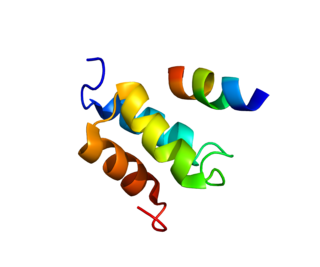ATP-binding cassette sub-family D member 2 is a membrane pump/transporter protein that in humans is encoded by the ABCD2 gene. [5] [6]
ATP-binding cassette sub-family D member 2 is a membrane pump/transporter protein that in humans is encoded by the ABCD2 gene. [5] [6]
The protein encoded by this gene is a member of the superfamily of ATP-binding cassette (ABC) transporters. ABC proteins transport various molecules across extra- and intra-cellular membranes. ABC genes are divided into seven distinct subfamilies (ABC1, MDR/TAP, MRP, ALD, OABP, GCN20, White). This protein is a member of the ALD subfamily, which is involved in peroxisomal import of fatty acids and/or fatty acyl-CoAs in the organelle. All known peroxisomal ABC transporters are half transporters which require a partner half transporter molecule to form a functional homodimeric or heterodimeric transporter. The function of this peroxisomal membrane protein is unknown; however this protein is speculated to function as a dimerization partner of ABCD1 and/or other peroxisomal ABC transporters. [6]
Mutations in this gene have been observed in patients with adrenoleukodystrophy, a severe demyelinating disease. This gene has been identified as a candidate for a modifier gene, accounting for the extreme variation among adrenoleukodystrophy phenotypes. This gene is also a candidate for a complement group of Zellweger syndrome, a genetically heterogeneous disorder of peroxisomal biogenesis. [6]

ABCD1 is a protein that transfers fatty acids into peroxisomes.

Bradykinin receptor B2 is a G-protein coupled receptor for bradykinin, encoded by the BDKRB2 gene in humans.

Canalicular multispecific organic anion transporter 2 is a protein that in humans is encoded by the ABCC3 gene.

Peroxisome biogenesis factor 1, also known as PEX1, is a protein which in humans is encoded by the PEX1 gene.

Peroxisomal biogenesis factor 19 is a protein that in humans is encoded by the PEX19 gene.

ATP-binding cassette sub-family G member 8 is a protein that in humans is encoded by the ABCG8 gene.

ATP-binding cassette sub-family A member 2 is a protein that in humans is encoded by the ABCA2 gene.

ATP-binding cassette sub-family D member 3 is a protein that in humans is encoded by the ABCD3 gene.

Peroxisomal biogenesis factor 2 is a protein that in humans is encoded by the PEX2 gene.

Peroxisomal biogenesis factor 3 is a protein that in humans is encoded by the PEX3 gene.

ATP-binding cassette sub-family B member 9 is a protein that in humans is encoded by the ABCB9 gene.

ATP-binding cassette sub-family A member 3 is a protein that in humans is encoded by the ABCA3 gene.

ATP-binding cassette super-family B member 6, mitochondrial is a protein that in humans is encoded by the ABCB6 gene.

Peroxisomal membrane protein PEX16 is a protein that in humans is encoded by the PEX16 gene.

Acyl-CoA Synthetase, Bubblegum Family, member 1 (ACSBG1) is an enzyme that in humans is encoded by the ACSBG1 gene.

Peroxisomal membrane protein 11B is a protein that in humans is encoded by the PEX11B gene. It is involved in the regulation of peroxisome abundance.

ATP-binding cassette sub-family D member 4 is a protein that in humans is encoded by the ABCD4 gene.

ATP-binding cassette sub-family G member 4 is a protein that in humans is encoded by the ABCG4 gene.

ATP-binding cassette sub-family A member 8 is a protein that in humans is encoded by the ABCA8 gene.

Multidrug resistance-associated protein 9 is a protein that in humans is encoded by the ABCC12 gene.
This article incorporates text from the United States National Library of Medicine, which is in the public domain.